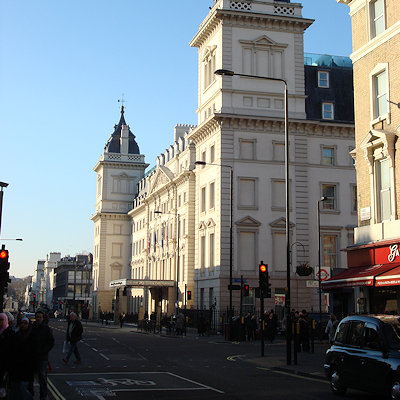
Like us on Facebook
PLACE NAMES


 
|
|
Paddington
|

| |
The earliest extant references to Padington, historically a part of Middlesex, appear in documentation of purported 10th-century land grants to the monks of Westminster by Edgar the Peaceful as confirmed by Archbishop Dunstan. However, the documents' provenance is much later and likely to have been forged after the 1066 Norman conquest. There is no mention of the place (or Westbourne or Knightsbridge) in the Domesday Book of 1086. It has been reasonably speculated that a Saxon settlement was located around the intersection of the northern and western Roman roads, corresponding with the Edgware Road (Watling Street) and the Harrow and Uxbridge Roads. A more reliable 12th-century document cited by the cleric Isaac Maddox (1697-1759) establishes that part of the land was held by brothers "Richard and William de Padinton".
In the later Elizabethan and early Stuart era, the rectory, manor and associated estate houses were occupied by the Small (or Smale) family. Nicholas Small was a clothworker who was sufficiently well connected to have Holbein paint a portrait of his wife, Jane Small. Nicholas died in 1565 and his wife married again, to Nicholas Parkinson of Paddington who became master of the Clothworker's company. Jane Small continued to live in Paddington after her second husband's death, and her manor house was big enough to have been let to Sir John Popham, the attorney general, in the 1580s. They let the building that became in this time Blowers Inn.
As the regional population grew in the 17th century, Paddington's ancient Hundred of Ossulstone was split into divisions; Holborn Division replaced the hundred for most administrative purposes. By 1773, a contemporary historian felt and wrote that "London may now be said to include two cities, one borough and forty six antient [ancient] villages [among which]... Paddington and [adjoining] Marybone (Marylebone)."
Roman roads formed the parish's north-eastern and southern boundaries from Marble Arch: Watling Street (later Edgware Road) and; (the) Uxbridge road, known by the 1860s in this neighbourhood as Bayswater Road. They were toll roads in much of the 18th century, before and after the dismantling of the permanent Tyburn gallows "tree" at their junction in 1759 a junction now known as Marble Arch. By 1801, the area saw the start-point of an improved Harrow Road and an arm of the Grand Junction Canal (Grand Union Canal) - these remain.
Paddington station is the terminus for commuter services to the west of London (e.g. from/to Slough, Maidenhead, Reading, Swindon) and mainline services to Oxford, South-West England (including Bristol, Bath, Taunton, Exeter, Plymouth and Cornwall) and South Wales (including Cardiff, Bridgend and Swansea). The Heathrow Express serves Heathrow Airport.
In the station are statues of its designer, Isambard Kingdom Brunel, and the children's fiction character Paddington Bear.
|
 Feel free to Email me any additions or corrections Feel free to Email me any additions or corrections
LINKS AVAILABLE TO YOUR SITE
| |





